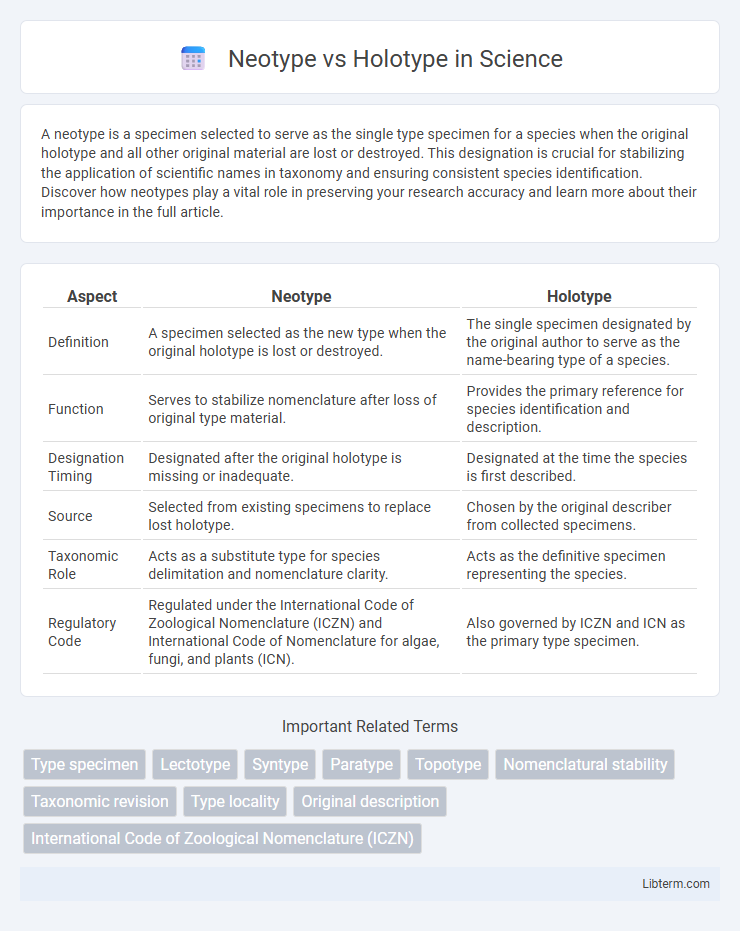A neotype is a specimen selected to serve as the single type specimen for a species when the original holotype and all other original material are lost or destroyed. This designation is crucial for stabilizing the application of scientific names in taxonomy and ensuring consistent species identification. Discover how neotypes play a vital role in preserving your research accuracy and learn more about their importance in the full article.
Table of Comparison
| Aspect | Neotype | Holotype |
|---|---|---|
| Definition | A specimen selected as the new type when the original holotype is lost or destroyed. | The single specimen designated by the original author to serve as the name-bearing type of a species. |
| Function | Serves to stabilize nomenclature after loss of original type material. | Provides the primary reference for species identification and description. |
| Designation Timing | Designated after the original holotype is missing or inadequate. | Designated at the time the species is first described. |
| Source | Selected from existing specimens to replace lost holotype. | Chosen by the original describer from collected specimens. |
| Taxonomic Role | Acts as a substitute type for species delimitation and nomenclature clarity. | Acts as the definitive specimen representing the species. |
| Regulatory Code | Regulated under the International Code of Zoological Nomenclature (ICZN) and International Code of Nomenclature for algae, fungi, and plants (ICN). | Also governed by ICZN and ICN as the primary type specimen. |
Introduction to Biological Type Specimens
Biological type specimens serve as reference points for species identification and classification, with a holotype being the single specimen designated by the original describer of a species. When the holotype is lost or destroyed, a neotype is appointed to act as the new standard for that species. This system ensures consistency and stability in taxonomic nomenclature by providing clear, physical examples tied to scientific names.
Defining Holotype: The Primary Reference
The holotype serves as the primary reference specimen for a species, providing the definitive example used in its original description and taxonomic identification. It anchors the species name, ensuring stability and clarity in biological classification by representing the exact organism upon which the species description is based. Unlike neotypes, which are designated when the original holotype is lost or destroyed, holotypes are crucial for maintaining consistent and accurate taxonomic references in biodiversity studies.
Understanding Neotype: Replacement of the Lost Holotype
A neotype serves as the designated replacement specimen for a lost or destroyed holotype in biological nomenclature, ensuring the stability and clarity of species identification. When the original holotype is no longer available, taxonomists select a neotype that best represents the defining characteristics of the species for accurate reference in future research. This practice maintains consistent classification and helps resolve taxonomic ambiguities caused by missing holotype specimens.
Historical Background of Type Specimens
Holotypes were first established in the 19th century as the single name-bearing specimen used to define a species, forming the cornerstone of taxonomic nomenclature. Neotypes were later introduced when the original holotype is lost or destroyed, ensuring continuity and stability in species identification. The historical evolution of these type specimens reflects the increasing need for precision and standardization in biological classification.
Criteria for Designating a Holotype
A holotype is designated based on its representation as the single physical specimen upon which a new species description is formally established, ensuring it exhibits definitive diagnostic characters. This specimen must be clearly identified, well-preserved, and accessible for study, serving as the ultimate reference point for taxonomic identification and comparison. In cases where the original holotype is lost or destroyed, a neotype may be selected to maintain nomenclatural stability, but the initial designation of a holotype follows strict criteria emphasizing authenticity and taxonomic clarity.
Reasons for Assigning a Neotype
A neotype is assigned when the original holotype specimen is lost, destroyed, or deemed inadequate for accurate identification of a species, ensuring taxonomic stability. This designation provides a reference point for species identification and resolves ambiguities caused by missing or damaged holotypes. Assigning a neotype follows strict guidelines outlined by the International Code of Zoological Nomenclature to maintain consistency in scientific classification.
Differences Between Neotype and Holotype
The holotype is the single specimen designated by the original describer as the name-bearing reference for a species, ensuring taxonomic clarity. In contrast, a neotype is selected when the holotype is lost, destroyed, or deemed inadequate, serving as a replacement to stabilize nomenclature. Holotypes anchor species names from initial descriptions, while neotypes are secondary designations established under specific circumstances to maintain taxonomic consistency.
Importance in Taxonomic Nomenclature
Neotypes and holotypes serve as critical reference specimens in taxonomic nomenclature, ensuring stability in species identification and classification. Holotypes are the original specimens designated at the time of species description, providing a definitive reference for the species name, while neotypes are designated later when the holotype is lost or deemed inadequate, maintaining continuity in taxonomy. The precise use of holotypes and neotypes is essential for resolving taxonomic ambiguities and supporting consistent species delimitation across scientific research.
Case Studies: Holotype vs Neotype in Practice
Holotypes serve as the original reference specimens for species identification, but when these are lost or destroyed, neotypes are designated to preserve taxonomic stability. Case studies, such as the replacement of the lost holotype of the dodo (Raphus cucullatus) with a neotype, demonstrate how neotypes maintain clarity in species classification and prevent nomenclatural confusion. The careful selection and validation process in these cases ensure continuity in biological research and biodiversity records.
Implications for Scientific Research and Conservation
Neotypes serve as replacement specimens when original holotypes are lost or deemed inadequate, ensuring taxonomic clarity and stability that supports consistent scientific research. The accurate designation of a holotype provides an unequivocal reference critical for species identification, facilitating effective biodiversity assessments and conservation strategies. Misidentification or absence of holotypes can impede ecological studies and conservation planning by creating data inconsistencies and undermining species protection policies.
Neotype Infographic

 libterm.com
libterm.com